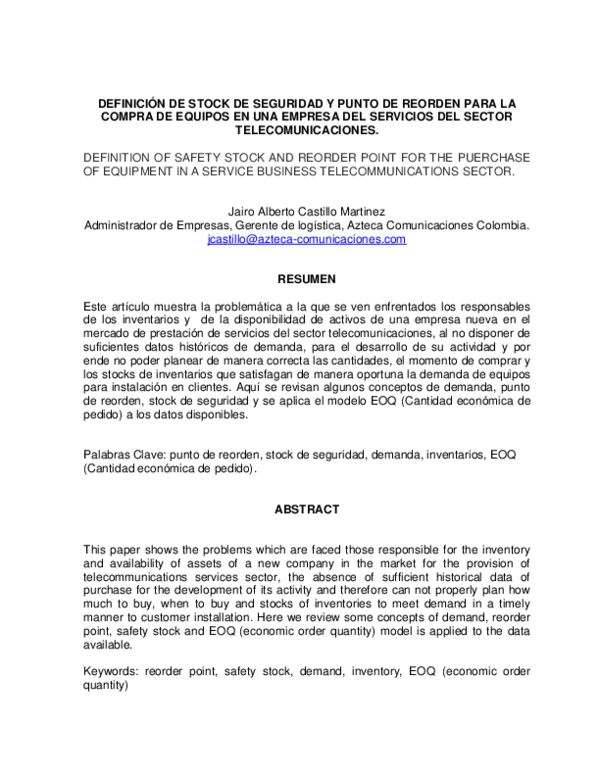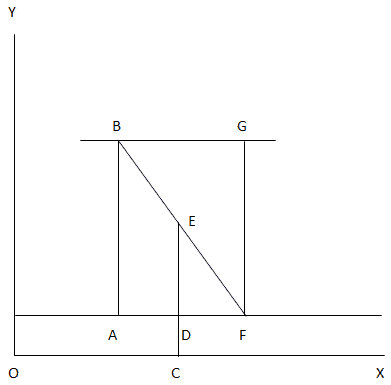In the EOQ (Economic Order Quantity) model, it was assumed that there is no time lag between ordering and procuring of materials. Therefore the reorder point for replenishing the stocks occurs at that level when the inventory level drops to zero and because instant delivery by suppliers, the stock level bounce back.
Is it reorder or re order?
When first presented with a label of “Re-order” it looked weird to me but my Googling left me more confused that resolved on the matter. Merriam-Webster indicates that “reorder” applies to both ordering again, and arranging in a different order.
But what is it and how can an ideal ordering point be determined? Therefore, an ideal reorder point is typically a little higher than your safety stock level to factor in delivery time. It depends on the average lead time of your reorder and the average demand during the lead time period. A reorder point is the unit quantity on hand that triggers the purchase of a predetermined amount of replenishment inventory. If the purchasing process and supplier fulfillment work as planned, the reorder point should result in the replenishment inventory arriving just as the last of the on-hand inventory is used up.
It assumes that there is a trade-off between inventory holding costs and inventory setup costs, and total inventory costs are minimized when both setup costs and holding costs are minimized. Several factors determine how much delivery time stock and safety stock should be held. In summary, the efficiency of a replenishment system affects how much delivery time is needed.
Holding costs refer to all the costs associated with holding additional inventory on hand. Those costs include warehousing and logistical costs, insurance costs, material handling costs, inventory write-offs, and depreciation. We want to determine the optimal number of units to order so that we minimize the total cost associated with the purchase, delivery and storage of the product. Often times, managing inventory via an Economic Order Quantity, or EOQ, can be a very effective technique.
The result is no interruption in production and fulfillment activities, while minimizing the total amount of inventory on hand. The required parameters to the solution are the total demand for the year, the purchase cost for each item, the fixed cost to place the order and the storage cost for each item per year. Note that the number of times an order is placed will also affect the total cost, though this number can be determined from the other parameters. Economic Order Quantity is often one of many inventory planning techniques available in an inventory control or ERP solution.
The EOQ formula inputs make an assumption that consumer demand is constant. The calculation also assumes that both ordering and holding costs remain constant.
EOQ applies only when demand for a product is constant over the year and each new order is delivered in full when inventory reaches zero. There is a fixed cost for each order placed, regardless of the number of units ordered. There is also a cost for each unit held in storage, commonly known as holding cost, sometimes expressed as a percentage of the purchase cost of the item. The EOQ model seeks to ensure that the right amount of inventory is ordered per batch so a company does not have to make orders too frequently and there is not an excess of inventory sitting on hand.
EOQ considers the timing of reordering, the cost incurred to place an order, and costs to store merchandise. If a company is constantly placing small orders to maintain a specific inventory level, the ordering costs are higher, along with the need for additional storage space.
What does it mean to reorder something?
reorder – a repeated order for the same merchandise; “he’s the one who sends out all the new orders and reorders” purchase order, order – a commercial document used to request someone to supply something in return for payment and providing specifications and quantities; “IBM received an order for a hundred computers”

Arrange the parts (P, Q, R, S) to form a meaningful sentence: I walked on (P)until I reached (Q)my house (R)as fast as I could (S)the road which led to. The correct sequence should be :
- The economic order quantity (EOQ) model is used in inventory management by calculating the number of units a company should add to its inventory with each batch order to reduce the total costs of its inventory.
Another important extension of EOQ model is to consider items with imperfect quality. Salameh and Jaber are the first to study the imperfect items in an EOQ model very thoroughly. Malakooti has introduced the multi-criteria EOQ models where the criteria could be minimizing the total cost, Order quantity (inventory), and Shortages.
more stack exchange communities
Since the delivery time stock is the expected inventory usage between ordering and receiving inventory, efficient replenishment of inventory would reduce the need for delivery time stock. Holding costs associated with storing inventory are a major component of supply chain management because businesses must determine how much to keep in stock. The EOQ formula is the square root of (2 x 1,000 shirts x $2 order cost) / ($5 holding cost) or 28.3 with rounding. The ideal order size to minimize costs and meet customer demand is slightly more than 28 shirts. A more complex portion of the EOQ formula provides the reorder point.
To calculate the economic order quantity for inventory you must know the setup costs, demand rate, and holding costs. Economic order quantity (EOQ) is the ideal order quantity a company should purchase to minimize inventory-related expenses such as holding costs, shortage costs, and order costs. Economic order quantity (EOQ) is the ideal order quantity that a company should make for its inventory given a set cost of production, demand rate, and other variables.
If the quantity exceeds maximum level limit then it will be termed as overstocking. A firm avoids overstocking because it will result in high material costs. Overstocking will lead to the requirement of more capital, more space for storing the materials, and more charges of losses from obsolescence. Reordering level is fixed between minimum level and maximum level.
For example, ABC International uses an average of 25 units of its green widget every day, and the number of days it takes for the supplier to replenish inventory is four days. Therefore, ABC should set the reorder point for the green widget at 100 units. When the inventory balance declines to 100 units, ABC places an order, and the new units should arrive four days later, just as the last of the on-hand widgets are being used up.
Reorder point
The economic order quantity (EOQ) model is used in inventory management by calculating the number of units a company should add to its inventory with each batch order to reduce the total costs of its inventory. In inventory management, economic order quantity (EOQ) is the order quantity that minimizes the total holding costs and ordering costs. The reorder point (ROP) is the level of inventory which triggers an action to replenish that particular inventory stock. It is a minimum amount of an item which a firm holds in stock, such that, when stock falls to this amount, the item must be reordered. It is normally calculated as the forecast usage during the replenishment lead time plus safety stock.
Its main purpose is to help a company maintain a consistent inventory level and to reduce costs. EOQ uses variable annual usage amount, order cost and warehouse carrying cost. Companies can use the EOQ equation to effectively determine the most cost-effective number of goods to order in correlation to operating costs of the business. Many inventory management software options will automatically calculate your reorder point and process purchase orders for you, helping to reduce the risk of stockouts. It is the quantity of materials beyond which a firm should not exceed its stocks.
The rate of consumption, number of days required to replenish the stocks, and maximum quantity of materials required on any day are taken into consideration while fixing reordering level. A reorder point graph showing the boundaries calculated by a reorder point formula. Get your reorder point calculations correct, and your demand never has to eat into your safety stock levels. Reorder point calculation formula and safety stock calculation formula are in a way two sides of the same coin. Safety stock describes the amount of inventory a business keeps in the warehouse to protect against spikes in demand or shortages in supply.
reorder
Ordering a large amount of inventory increases a company’s holding costs while ordering smaller amounts of inventory more frequently increases a company’s setup costs. The economic order quantity model finds the quantity that minimizes both types of costs. Several extensions can be made to the EOQ model, including backordering costs and multiple items. Additionally, the economic order interval can be determined from the EOQ and the economic production quantity model (which determines the optimal production quantity) can be determined in a similar fashion.

By definition, Economic Order Quantity is a formula used to calculate inventory stocking levels. Please note that the reorder point only indicates when to place a replenishment order; it does not calculate the amount of items that should be ordered (which is addressed by the economic order quantity formula). Better yet, consider using a just-in-time or material requirements planning system, which only order new inventory when there is a specific, identified reason for doing so. The basic formula for the reorder point is to multiply the average daily usage rate for an inventory item by the lead time in days to replenish it.